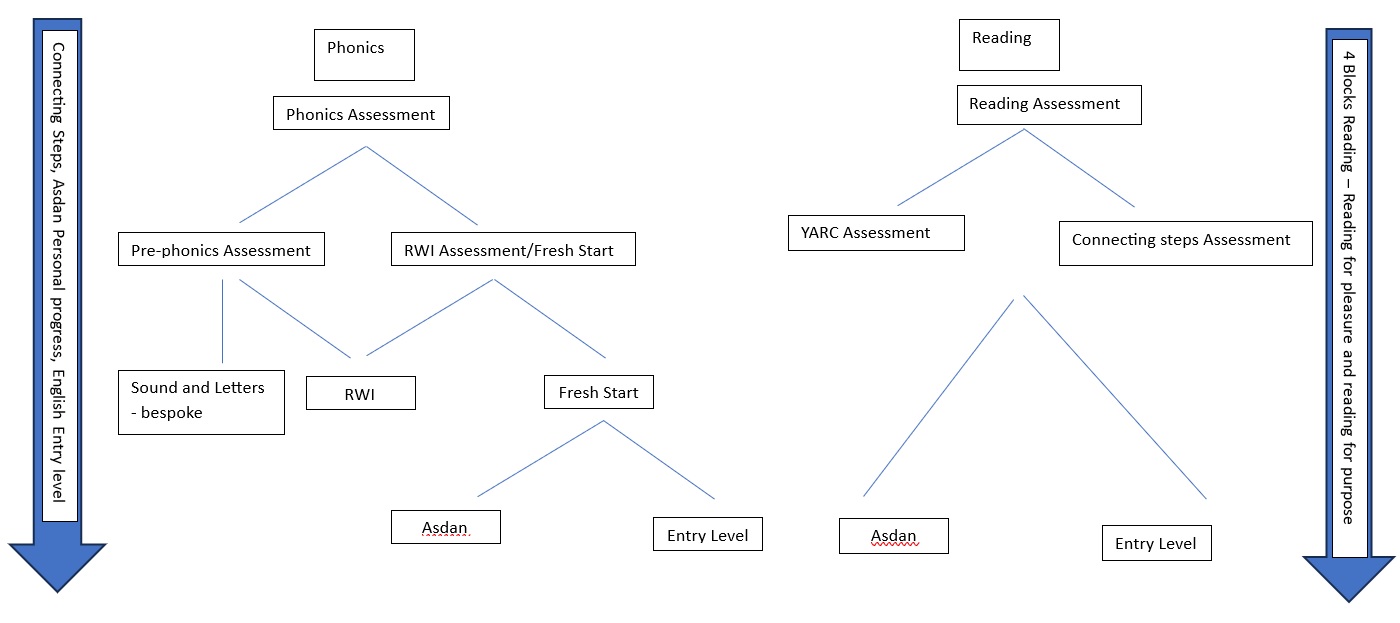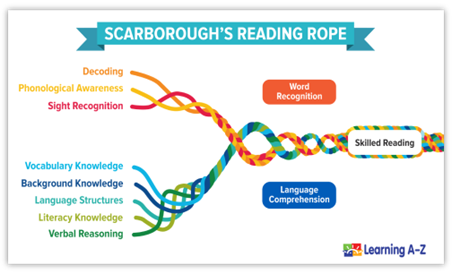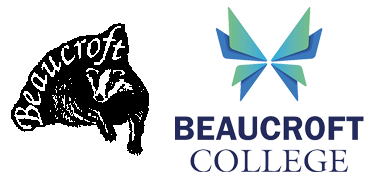Beaucroft Literacy Progression Overview
Expectations of progression and end points are set out within the learning journeys, outcomes of which come from EHCPs, and are therefore entirely individual.
Within each department (key stage) there is examples of each curriculum class set up – pre-formal, semi formal, formal and nurture – and in these different curriculum pathways progress is likely to look different. Pre-formal classes are likely to make lateral progress, consolidating on skills and broadening the regularity of tasks, and the breadth they can achieve these in (with different staff, with different materials etc) In semi-formal and formal classrooms learners may regularly add to skills and expand on these incrementally throughout their journey at Beaucroft. Those following a nurture curriculum may progress along both routes, depending on their needs and individual outcomes set out in their EHCP and learning journey.
From any pathway accreditation can be reached in Seniors and P16 through Personal progress (ASDAN) or Functional Skills/Entry Level Certificate (Pearson) but our primary aim isn’t only qualifications, but to prepare our learners for the world beyond Beaucroft, to build life skills enabling them to be as independent as possible, with ways of communicating purposefully, to ensure every person can make their emotional and physical basic needs met (as a minimum – no ceiling is too high to break!)
Phonics at Beaucroft
At Beaucroft we use Read, Write, Inc. to teach our pupils phonics. This is an evidence based reading strategy and uses systematic synthetic phonics (SSP) which teach decoding explicitly. We adapt this scheme to suit the needs of our learners. We use sounds of the week, purpose made visuals e.g. symbols, switches, sound sacks, real objects, a variety of books and online programmes to support with this. We also recognise that not all pupils will be suited to a systematic programme and we also use See and learn strategies to support with phonological awareness, developing early vocabulary and beginning to read sight words.
Four Blocks Literacy Model
The Four Blocks Literacy Model is the umbrella which spans over all areas of literacy across the main part of the school.
Self-selected reading:
- Reading for pleasure.
- Choosing content independently.
- Enjoying a range of literary content (magazines, websites, comics, leaflets, signs and symbols).
- Every classroom should have a selection of literary items available to their learners.
Shared and guided reading:
- Sharing books with an adult (including RWInc).
- Reading to, and with your class.
- Reasons for reading activities –engagement and comprehension.
Writing:
- Mark making/sensory mark making.
- Reasons for writing – writing to teachers/office/home/sending and receiving messages (written or sound recorded).
- Read Write Inc – mnemonics for letter formation.
- See and learn – matching words, seeing words in the community (café/shopping).
- Self-authored books.
Working with words:
- Read Write Inc programme – phonic awareness, phonic to grapheme correspondence established (what the letter sounds like and looks like).
- Blending sounds, decoding, building fluency and accuracy.
- Word walls reinforcing phonic knowledge and introducing new vocabulary. Alphabetic order.
Route to Reading
‘Literacy is at the heart of education; everything that we do revolves around the development of the ability to understand and communicate about the world around us. With the rise in technology, communication, and different ways to understand the world, literacy can be conceptualised in a much broader way. Literacy learning starts with interaction and experience but alongside this skills have to be learnt. To understand that print has meaning, or learn to read or write we need to begin with connecting the dots between what we hear and something that represents that sound, note, letter or word. There is no beginning and no end.
We do not suddenly start to teach reading to a child, we initially surround them in rich literacy experiences that start with sensory engagement and motivation, to support the development of a shared interest and communication. This can then lead onto greater depth of understanding, development of skills and later more formal literacy learning where appropriate. ‘ (Moseley 2023)

*Fresh Start scheme beginning December 2023
Scarborough’s Reading Rope
Here at Beaucroft we truly believe in the principle of Scarborough’s Reading rope, pupils need exposure and practise at every strand of the Reading rope to develop their reading ability to become fluent and skilled readers. We strive for every pupil to reach their full potential. Below you will see the Reading rope and a table to show the resources and methods we use.
Scarborough’s Reading Rope to encourage fluent reading, children need to exposed to all strands to reach their own reading potential.

| Language Comprehension | Word recognition |
| Background Knowledge Looking at what we already know and furthering knowledge using story planning, sensory stories, weekend news, topic related study, shared stories at school and at home. Reading for pleasure. | Phonological Awareness Being aware of phonemes, syllables, Following Read, Write inc and Fresh Start. Letter/sound of the week, sound of the day. Pre phonics environmental sounds, four blocks of literacy. |
| Vocabulary Learning new words and working with the words we know. Modelling teaching activities, listening to adults reading, Read, Write, Inc and Fresh start phonics scheme, communicate in print, signing, see and learn | Decoding Shared reading, home readers, letter/sound of the week. Adult modelling. Read, write, Inc and Fresh start. |
| Verbal Reasoning Exploring what words mean and how they are presented in texts. Adults modelling, comprehension activities, signing, Asdan personal progress and Entry level in English. | Sight Recognition See and learn, PECS, communicate in print, signing, shared reading, target time, words around school and in the community. |
| Literacy Knowledge Looking at a variety of genres through topic based literacy teaching. Asdan Personal progress Units and Entry level 1,2,&3 in English. Learning about books, language in the community, sharing books, four blocks of literacy, library visits. | |
| Language Structures semantics—how word choice develops meaning—and syntax, the grammatical rules of a language. This is explored through explicit teaching and exploring texts. |
